Longest increasing subsequences in involutions avoiding patterns of length three
Longest increasing subsequences in involutions avoiding patterns of length three
___
- [1] Aldous D, Diaconis P. Longest increasing subsequences: from patience sorting to the Baik-Deift-Johansson theorem. Bulletin of the American Mathematical Society 1999; 36 (4): 413-432. doi: 10.1090/S0273-0979-99-00796-X
- [2] Baik J, Deift P, Johansson K. On the distribution of the length of the longest increasing subsequence of random permutations. Journal of the American Mathematical Society 1999; 12 (4): 1119-1178. doi: 10.1090/S0894-0347- 99-00307-0
- [3] Baik J, Deift P, Suidan T. Combinatorics and Random Matrix Theory. Graduate Studies in Mathematics, Vol. 172. Providence, RI, USA: American Mathematical Society, 2016.
- [4] Bóna M. Combinatorics of Permutations, Second Edition. London, UK: Chapman and Hall/CRC Press, 2012.
- [5] Bóna M, Homberger C, Pantone J, Vatter V. Pattern-avoiding involutions: exact and asymptotic enumeration. Australasian Journal of Combinatorics 2016; 64: 88-119.
- [6] Chinn PZ, Grimaldi R, Heubach S. The frequency of summands of a particular size in palindromic compositions. Ars Combinatoria 2003; 69: 65-78.
- [7] Corwin I. Comments on David Aldous and Persi Diaconis’ “Longest increasing subsequences: from patience sorting to the Baik-Deift-Johansson theorem”. Bulletin of the American Mathematical Society 2018; 55: 363-374. doi: 10.1090/bull/1623
- [8] Deift P. Universality for mathematical and physical systems. In: Proceedings of the International Congress of Mathematicians, Vol. I; Madrid, Spain; 2006. pp. 125-152. doi: 10.4171/022-1/7
- [9] Deutsch E, Hildebrand AJ, Wilf HS. Longest increasing subsequences in pattern-restricted permutations. Electronic Journal Combinatorics 2002; 9 (2): 12.
- [10] Dukes WMB, Jelínek V, Mansour T, Reifegerste A. New equivalences for pattern avoiding involutions. Proceedings of the American Mathematical Society 2009; 137 (2): 457-465.
- [11] Egge E, Mansour T. 231-avoiding involutions and Fibonacci numbers. Australasian Journal of Combinatorics 2004; 30: 75-84.
- [12] Egge E, Mansour T. Bivariate generating functions for involutions restricted by 3412. Advances in Applied Mathematics 2006; 36 (2): 118-137. doi.org/10.1016/j.aam.2005.01.005
- [13] Erdös P, Szekeres G. A combinatorial theorem in geometry. Compositio Mathematica 1935; 2: 463-470.
- [14] Flajolet P, Sedgewick R. Analytic Combinatorics. Cambridge, UK: Cambridge University Press, 2009.
- [15] Guibert O. Combinatoire des permutations à motifs exclus en liaison avec mots, cartes planaires et tableaux de Young. PhD, Université Bordeaux, Bordeaux, France, 1995 (in French).
- [16] Guibert O, Mansour T. Restricted 132-involutions. Séminaire Lotharingien de Combinatoire 2002; 48: B48a.
- [17] Guibert O, Mansour T. Some statistics on restricted 132 involutions. Annals of Combinatorics 2002; 6: 349-374.
- [18] Hammersley JM. A few seedlings of research. In: Proceedings of the Sixth Berkeley Symposium on Mathematical Statistics and Probability, Vol. 1; Berkeley, CA, USA; 1972. pp. 345–394.
- [19] Hoffman C, Rizzolo D, Slivken E. Fixed points of 321-avoiding permutations. Proceedings of the American Mathematical Society 2019; 147 (2): 861-872. doi: 10.1090/proc/14299
- [20] Jaggard AD, Marincel JJ. Generating-tree isomorphisms for pattern-avoiding involutions. Annals of Combinatorics 2011; 15 (3): 437-448. doi: 10.1007/s00026-011-0101-x
- [21] Kemp R. On the average depth of a prefix of the Dycklanguage D1 . Discrete Mathematics 1981; 36: 155-170. doi: 10.1016/0012-365X(81)90235-1
- [22] Madras N, Pehlivan L. Large deviations for permutations avoiding monotone patterns. Electronic Journal of Combinatorics 2016; 23 (4): P4.36.
- [23] Madras N, Yıldırım G. Longest monotone subsequences and rare regions of pattern-avoiding permutations. Electronic Journal of Combinatorics 2017; 24 (4): 1-29.
- [24] Miner S, Rizzolo D, Slivken E. Asymptotic distribution of fixed points of pattern-avoiding involutions. Discrete Mathematics Theoretical Computer Science 2017; 19 (2): 5. doi: 10.23638/DMTCS-19-2-5
- [25] Riordan J. Combinatorial Identities. New York, NY, USA: John Wiley, 1968.
- [26] Romik D. The Surprising Mathematics of Longest Increasing Subsequences. Institute of Mathematical Statistics Textbooks. Cambridge, UK: Cambridge University Press, 2015. doi: 10.1017/CBO9781139872003
- [27] Schensted C. Longest increasing and decreasing subsequences. Canadian Journal of Mathematics 1961; 13: 179-191. doi: 10.4153/CJM-1961-015-3
- [28] Simion R, Schmidt FW. Restricted permutations. European Journal of Combinatorics 1985; 6 (4): 383-406. doi: 10.1016/S0195-6698(85)80052-4
- [29] Sloane NJ. The On-Line Encyclopedia of Integer Sequences, 2010. Available at https://oeis.org/.
- ISSN: 1300-0098
- Yayın Aralığı: 6
- Yayıncı: TÜBİTAK
Elvan AKIN, Taher S HASSAN, Özkan ÖZTÜRK, İsmail Uğur TİRYAKİ
Subclasses of uniformly convex and starlike functions associated with Bessel functions
Muhammad NAEEM, Saqib HUSSAIN, Tahir MAHMOOD, Akhter RASHEED, F. Müge SAKAR
Quasi-idempotent ranks of some permutation groups and transformation semigroups
